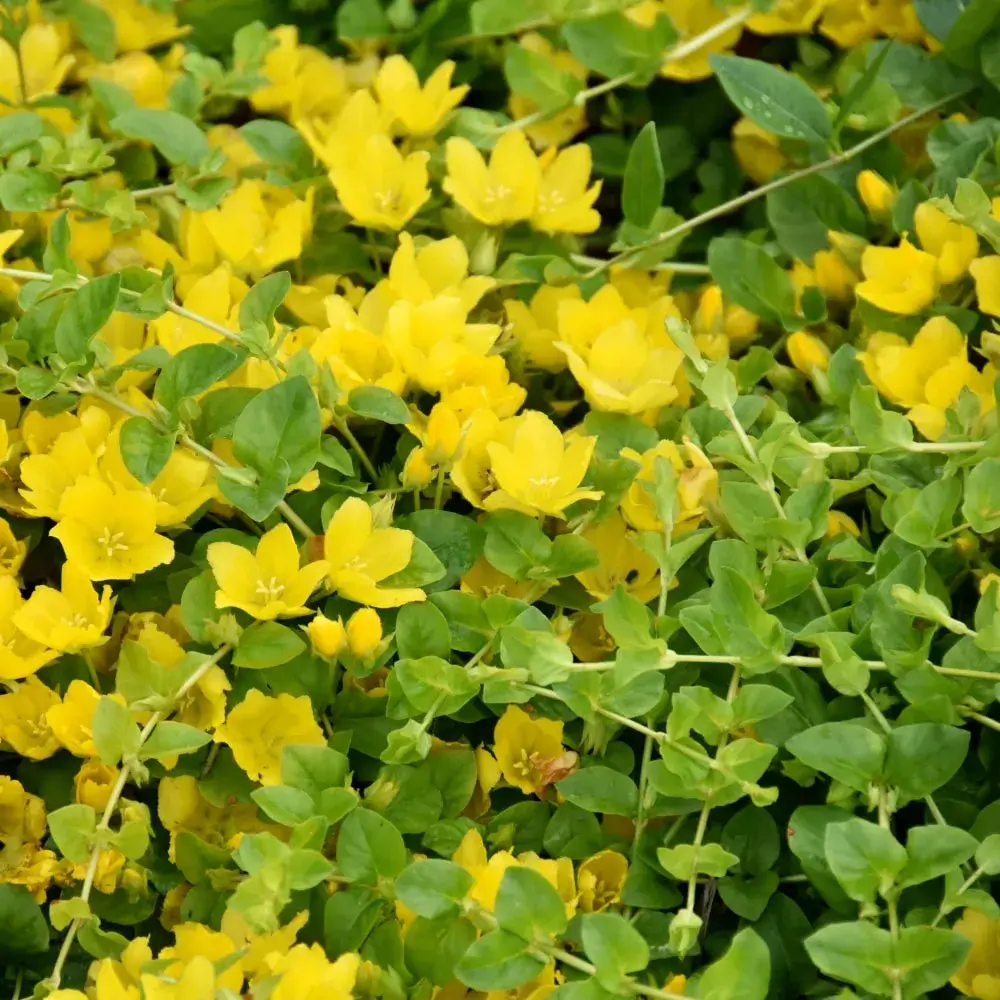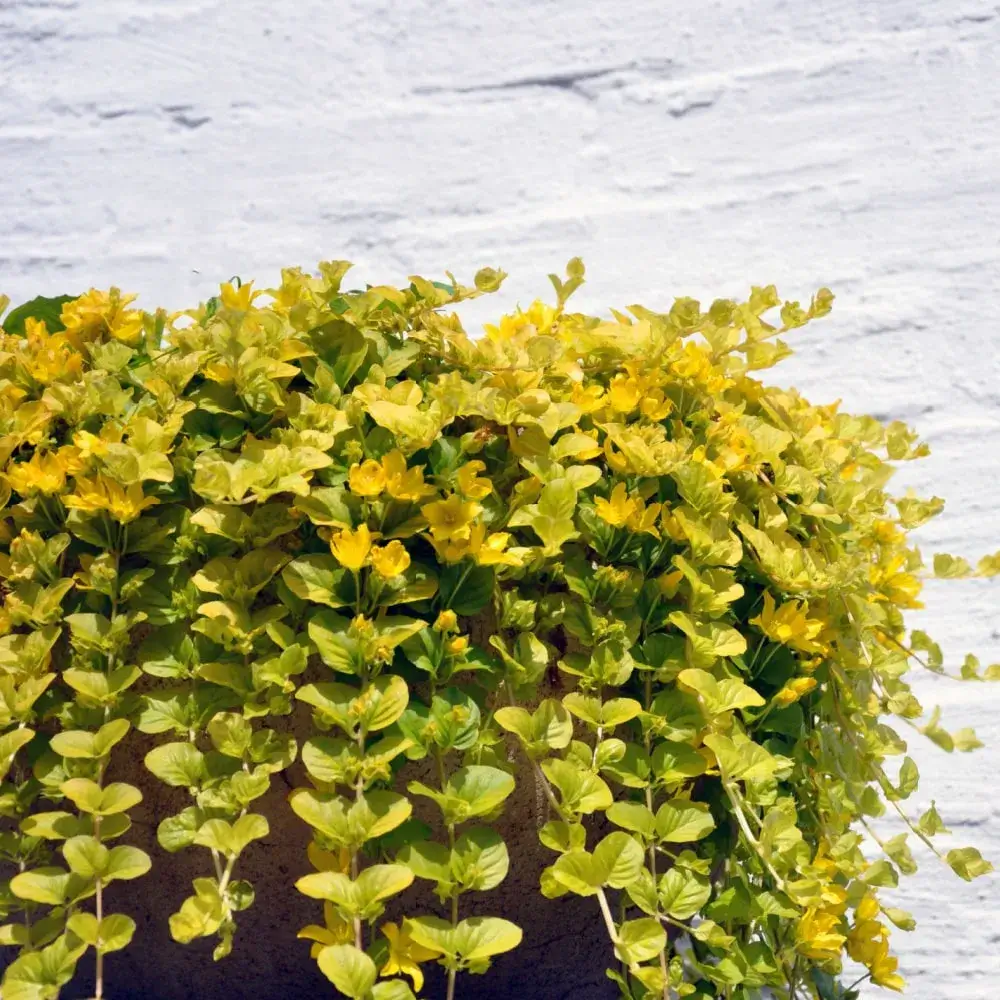Family: Loosestrife
Type: Perennial
Other Common Name: Moneywort

Creeping Jenny, a vibrant ground cover, thrives in moist, shaded areas. Its bright, coin-shaped leaves form a dense mat, adding a pop of color.
Easily adaptable, this plant spreads quickly, making it a popular choice for filling gaps. Its cascading nature suits hanging baskets and wall plantings.
This perennial remains evergreen in milder climates, providing year-round interest. It’s also known for its tiny, yellow flowers in spring and summer.
Hardiness Zone: 2a-4a
Pet Friendly: Yes
Moisture Preference: Average to moist
Sun Needs: Full sun to shade
Growth Rate: Fast
Average Height (feet): 0.5
Average Spread (feet): 3
Average Life Span (years): 10
Form: Spreading
Flower Color: Yellow
Flower Shape: Cup
Bloom Season: From late spring to mid summer
Foliage Color: Green
Foliage Shape: Round
Creeping Jenny is ideal for creating seamless transitions in garden beds. It blends well with taller plants, offering a lush undergrowth.
Incorporate it near water features or along pathways for a soft, inviting look. Its rapid growth covers unsightly bare patches effectively.
Use it to edge borders or as a lawn alternative in shady areas. Its tolerance for foot traffic makes it a versatile ground cover.

In cottage gardens, Creeping Jenny's informal growth pattern complements classic perennials. It adds a whimsical, dense ground layer beneath roses and lavender.
Perfect for woodland gardens, Creeping Jenny thrives under tree canopies. Its vibrant leaves contrast beautifully with ferns and hostas.
In modern landscapes, use Creeping Jenny for a bold, monochromatic look. It pairs well with structural plants, creating striking green canvases.
Pair Creeping Jenny with spring bulbs for a dynamic display. As bulbs fade, its foliage fills in, maintaining continuous color.
For a water garden, let it drape over pond edges. Its reflective leaves enhance the tranquil water features.
Mix with annuals for seasonal color. Creeping Jenny’s consistency complements the changing hues of annual flowers.
Select our pre-made garden layouts to create a landscape that’s uniquely yours. Simple, smart, and customizable!
In spring, Creeping Jenny sports bright green leaves and delicate yellow flowers. It creates a lively contrast with spring bulbs.
During summer, its foliage deepens in color, providing a lush carpet. It's particularly stunning next to water, reflecting the sunlight.
In fall, Creeping Jenny's leaves may turn a golden bronze, adding warmth. It remains dense, cushioning the fall landscape.
In milder winters, Creeping Jenny stays evergreen, offering rare winter color. Its persistence brightens the dormant garden beds.
Creeping Jenny flourishes in areas with ample moisture and partial to full shade. Ideal spots include damp garden corners, around ponds, or under tree canopies.
This plant prefers shaded to partially shaded areas. Too much sunlight can scorch its leaves, while too little may reduce its vibrant color.
Creeping Jenny isn't picky about soil but grows best in moist, well-draining soil. It can tolerate a range of soil types, from clay to sandy.
When planting, space them about 12 to 18 inches apart. This allows room for growth while ensuring quick ground cover formation.
The best time to plant Creeping Jenny is in the spring or early fall. This timing allows the plant to establish itself before extreme temperatures.
Plant Creeping Jenny at the same depth it was in the pot. Water thoroughly after planting to settle the soil around the roots.
Regular watering is crucial, especially in dry conditions. Keep the soil consistently moist but not waterlogged.
Apply a balanced, slow-release fertilizer in early spring. Over-fertilizing can lead to excessive growth at the expense of flowering.
Trim back as needed to control growth and encourage denser foliage. Pruning is especially important in areas where it might become invasive.
In spring, remove any dead foliage and apply fertilizer. This prepares Creeping Jenny for vigorous growth.
Monitor watering during hot periods. Mulching helps retain soil moisture and keeps roots cool.
Cut back the plant to control its spread. Prepare it for winter by ensuring the soil is not too damp.
In colder regions, provide a light mulch layer for root protection. In milder climates, little winter care is needed.
Creeping Jenny can be invasive in some regions. It’s essential to manage its spread through regular pruning and by choosing appropriate planting locations.
While it tolerates some sun, full sun can cause leaf burn. It’s best in partial shade to maintain its vibrant color.
Creeping Jenny is a fast grower. In favorable conditions, it can quickly cover large areas, making it an excellent choice for rapid ground coverage.
Sign up below to get exclusive deals, discounts, and new plant collections—delivered straight to your inbox! Plus, stay inspired with the latest gardening tips, landscaping trends, and DIY garden ideas. Start growing with us today!
A big thank you for subscribing to the PBN Design newsletter.
We're thrilled to have you join our community. Get ready for exciting updates, insightful content, and more delivered straight to your inbox.
Stay tuned!
Go backA big thank you for subscribing to the PBN Design newsletter.
We're thrilled to have you join our community. Get ready for exciting updates, insightful content, and more delivered straight to your inbox.
Stay tuned!
Go back